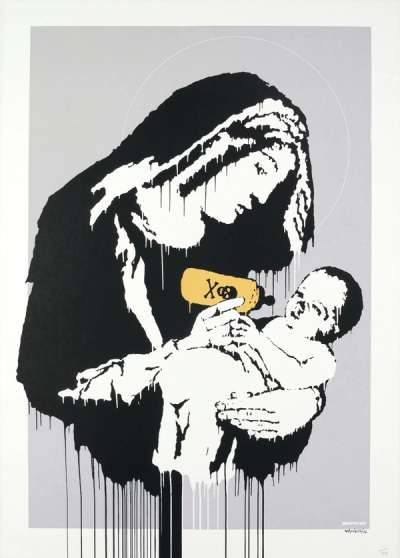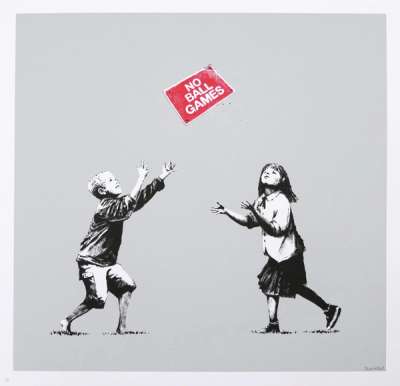Banksy's Fallen Angel

 Fallen Angel © Banksy 2004
Fallen Angel © Banksy 2004
Banksy
268 works
In Fallen Angel, Banksy captures the dichotomy of despair and divinity, portraying a figure that resonates with pathos and potential redemption. Created in 2004, this unsigned spray paint on cardboard piece juxtaposes the gritty reality of urban life with ethereal elements, depicting a man in a tracksuit, the glow of a halo, and the shadow of a cross. Banksy's work is a silent sermon on societal neglect and the inherent worth found in the forgotten corners of human existence.
Fallen Angel: Meaning & Analysis
In Fallen Angel, Banksy presents a visual narrative rich in symbolism, encapsulating the struggle between earthly despondency and the quest for salvation. The image of a man, slouched next to a bottle and lost in a moment of contemplation, is starkly human. Yet, the halo and wings afford him a contrasting divine aspect. Banksy's choice of a tracksuit for the figure’s attire universalises the subject, suggesting that such a fall from grace could happen to anyone in the fabric of modern society.
The figure's halo and wings, typically symbolic of purity and virtue, are here rendered in a context of defeat, suggesting a loss of innocence or a fall from societal grace. The quasi-religious cross, painted in a fragmented manner with drips of black paint cascading down the composition, invokes the imagery of imprisonment and societal abandonment.
Banksy's use of simple materials – spray paint and cardboard – contrasts with the complex subject matter, underscoring the tension between the value of art and the value of human life as perceived by society. The angel, a figure meant to ascend, is grounded in the harshness of reality, surrounded by the metaphorical bars of his own making or perhaps imposed upon him by the structures of society.
The artwork explores the theme of the fallen angel not as a supernatural event but as a metaphor for societal downfall. It is an introspection into the human condition, a critique of the ease with which society casts aside those who stumble. Banksy's angel is not fallen from heaven but from the grace of human compassion, sitting in the shadows cast by the very structures that should offer support.
“Here, Banksy presents the fallen angel not as a celestial being but as a metaphor for the harsh realities of societal abandonment and the loss of human compassion in contemporary society.”

Reflections On Banksy's Fallen Angel
Banksy’s Fallen Angel evokes a sense of confinement and yet, paradoxically, an aura of sanctity. The man, depicted in a state of dejection, is nevertheless bathed in a light that transforms his silhouette into a beacon of latent hope.
The black drips that cascade from the fragmented cross, resembling bars, symbolise the societal constraints and personal afflictions that bind the figure. Yet, the luminosity that adorns his halo and wings speaks of an inherent nobility, an untouched purity that endures despite the grittiness of his reality. Banksy captures the essence of the human spirit's resilience – the ability to retain a semblance of grace even when cast into the darkest of circumstances.












